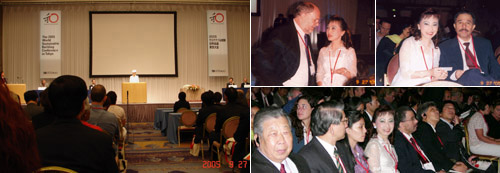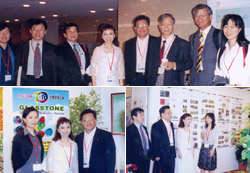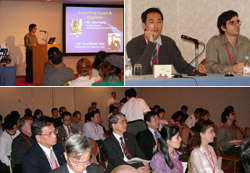Archilife Investingating Mission for SB05Tokyo (6)Date: 2005-09-28
Section: SB Series of International Conferences | 9月27日一早,黃晉英秘書長首先進行任務分組並宣布分組名單,隨後考察團一行在黃晉英秘書長的帶領下參加SB05Tokyo的開幕式及第一全會等會議,本次大會的主題與行動為化永續為行動(Action for sustainability)、區域化、跨世代以及消弭存在環境、社經、相關利益團體間與地域間的鴻溝。開幕式中,除由大會主席村上周三教授及日本土地、公共建設與運輸部部長Shigetaro Yamamoto先生上台致詞外,本次亦邀請到日本天皇姪子的太子妃蒞臨致詞,也讓所有與會人士有緣目睹日本皇室的風采及所受到的禮遇與尊榮。緊接著,在俐落、不拖泥帶水且幾乎分秒不差的流程掌控下,展開第一全會。邀請到的專題演講人為德國籍的Ernst Ulrich von Weizsacker博士,發表為時一小時,主題為 "Buildings Technology in the Vanguard of Ecoefficiency" 的專題演說,內容大綱為現今世界是貧窮者無能力改善環境,而富有者因改善環境而更浪費現有資源,所以經濟與環保應是行動而不是限制生活的觀念,且以提升資源生產力與提高資源使用效率等概念來代替限制生活,Weizsacker博士並舉出了許多實例,來印證他所提出的理論,並介紹其暢銷全球的著作「四倍數(Factor Four)」供與會人士參考。會後,黃晉英秘書長特別轉達一份 "Symbiotic Civilization" 的講稿予Ernst Ulrich von Weizsacker博士,希望讓他對共生化概念有更完整及全面的認知。

In the early morning of September 27, Secretary General Huang Chin-ying assigned the duty to different teams and announced the name list of the teams. Under the leadership of Secretary General Huang Chin-ying, the delegation arrived at the opening ceremony of SB05Tokyo and the First Plenary Session. The subject and action of the conference were : action for sustainability, regions; generation, bridging gaps; and bridging gaps between environmental, social, and economic aspects, various stakeholders concerns, and regional concerns. At the opening ceremony, in addition to the addresses given by Chairperson Shuzo Murakami and Minister Shigetaro Yamamoto of the Department of Land Administration, Public Construction and Transportation of Japan, the Mikado's niece-in-law was invited to deliver a speech, giving people there a chance to see the grace of the royalty and the courtesy and privilege given to them. The First Plenary Session started after a clean and brief but exact process control. It was Dr. Ernst Ulrich von Weizsacker from Germany who gave a one-hour keynote-speech on " Buildings Technology in the Vanguard of Ecoefficiency ". According to Dr. Ernst Ulrich von Weizsacker, poor people in the world were financially unable to improve the environment, while rich people were wasting more resources because they had money to make the improvement. Therefore, economics and environmental protection should be actions more than mere concepts in daily life; and to enhance the productivity and the efficiency of resources should replace restrictions in daily life. Dr. Ernst Ulrich von Weizsacker also gave many examples in real life to support his theories and introduced his world bestseller Factor Four to the participants. After the meeting, Secretary General Huang Chin-ying specially sent a copy of the speech " Symbiotic Civilization " to Dr. Ernst Ulrich von Weizsacker, hoping that he could have a clearer picture and idea of what symbiosis was.
在開幕式及第一全會中還有個小插曲,做事予人一向精準、效率及確實印象的日本,這次在餐券的印製上卻出了個小紕漏,讓來自加拿大的iiSBE秘書長Nils Larrson先生逮到機會戲謔了主辦單位。
There was an episode between the opening ceremony and the First Plenary Session. There was a minor mistake in the meal ticket so Secretary General Nils Larrson of the iiSBE of Canada had the chance to tease the Japanese who were believed to be accurate, efficiency and down-to-earth.
 下午,考察團員按所分配的任務組別,分頭參與各分組會議並蒐集發表論文之內容,沒有任務的團員則主動至Special Session的會場報到,參與本次學生會議(Student Session)的成果展現與報告。一如預期,由祐生主導之 "熱帶及亞熱帶地區永續建築之微氣候設計研討會" 的成果吸引許多的注目與迴響,也博得了滿堂彩。晚間,體恤團員辛勞的黃晉英秘書長特別央請導遊挑選位於品川王子飯店38樓Fujikawa高級餐廳,讓連日來處於緊繃狀態下的團員們能一邊眺望東京品川夜景,一邊享用頂級、豐盛的日式涮涮鍋,紓解身心的疲累。 下午,考察團員按所分配的任務組別,分頭參與各分組會議並蒐集發表論文之內容,沒有任務的團員則主動至Special Session的會場報到,參與本次學生會議(Student Session)的成果展現與報告。一如預期,由祐生主導之 "熱帶及亞熱帶地區永續建築之微氣候設計研討會" 的成果吸引許多的注目與迴響,也博得了滿堂彩。晚間,體恤團員辛勞的黃晉英秘書長特別央請導遊挑選位於品川王子飯店38樓Fujikawa高級餐廳,讓連日來處於緊繃狀態下的團員們能一邊眺望東京品川夜景,一邊享用頂級、豐盛的日式涮涮鍋,紓解身心的疲累。
 In the afternoon, members went to different unit meetings and collected papers presented there according to the duty assignment. Members who had no duty went to the Special Session spontaneously to participate in the accomplishment presentation and report of the Student Session. As it was expected, the accomplishment report of seminar on the workshop 2 : Bio-Climatic Design of SB in Tropical & Subtropical Region hosted by Archilife attracted many supports and echoes, and won heated applause. In the evening, Secretary General Huang Chin-ying asked the tour guide to make reservation at Fujikawa, a high-class restaurant on 38/F of Shinagawa Prince Hotel to thank all members of the delegation for their devotions and toils during the trip. Members of the delegation could partly enjoyed premium and delicious shabushabu and partly appreciate the night view of Tokyo as a reward for their toil. In the afternoon, members went to different unit meetings and collected papers presented there according to the duty assignment. Members who had no duty went to the Special Session spontaneously to participate in the accomplishment presentation and report of the Student Session. As it was expected, the accomplishment report of seminar on the workshop 2 : Bio-Climatic Design of SB in Tropical & Subtropical Region hosted by Archilife attracted many supports and echoes, and won heated applause. In the evening, Secretary General Huang Chin-ying asked the tour guide to make reservation at Fujikawa, a high-class restaurant on 38/F of Shinagawa Prince Hotel to thank all members of the delegation for their devotions and toils during the trip. Members of the delegation could partly enjoyed premium and delicious shabushabu and partly appreciate the night view of Tokyo as a reward for their toil.

 9月28日上午,本次有論文發表之團員李彥頤先生、湯淑貞小姐與張桂鳳小姐分別在Unit 3、Unit 16及Assessment Case Study Session 4進行投稿論文的演說報告,其餘考察團員依舊按所分配的任務組別,分頭參與各分組會議並蒐集發表論文之內容。而黃晉英秘書長則召集鍾政勳先生、蔡坤憲先生、李君如小姐及陳秋玉小姐為下午Unit 8的專題演講進行最後的彩排預演。下午,考察團員連袂前往參加第二全會,聆聽日本東京大學Ryoichi Yamamoto教授發表題為 "Eco design and Eco Efficiency as an Environmental-performance Indicator" 的專題演講,內容主要介紹日本於永續建築課題上的研究及其成果,政府部門於行政立法間的配合及立法。接著第二位來自巴西的建築師Jaime Lerner,演說 "The Sustainable City" ,內容大綱為城市如何發展,及於永續建築課題上可由何處著手,演說中特別提到:『城市發展不是問題,而是答案。』,並舉出了許多實際操作案例,來證實其論點。 9月28日上午,本次有論文發表之團員李彥頤先生、湯淑貞小姐與張桂鳳小姐分別在Unit 3、Unit 16及Assessment Case Study Session 4進行投稿論文的演說報告,其餘考察團員依舊按所分配的任務組別,分頭參與各分組會議並蒐集發表論文之內容。而黃晉英秘書長則召集鍾政勳先生、蔡坤憲先生、李君如小姐及陳秋玉小姐為下午Unit 8的專題演講進行最後的彩排預演。下午,考察團員連袂前往參加第二全會,聆聽日本東京大學Ryoichi Yamamoto教授發表題為 "Eco design and Eco Efficiency as an Environmental-performance Indicator" 的專題演講,內容主要介紹日本於永續建築課題上的研究及其成果,政府部門於行政立法間的配合及立法。接著第二位來自巴西的建築師Jaime Lerner,演說 "The Sustainable City" ,內容大綱為城市如何發展,及於永續建築課題上可由何處著手,演說中特別提到:『城市發展不是問題,而是答案。』,並舉出了許多實際操作案例,來證實其論點。
In the morning of September 28, Mr. Li Yen-yi, Miss Tang Shu-chen and Miss Chang Kuei-feng presented their papers at Unit 3, Unit 16 and Assessment Case Study Session 4 respectively. Others went to different unit meetings and collected papers presented there as usual. Secretary General Huang Chin-ying gathered Mr. Chung Cheng-hsin, Mr. Tsai Kun-hsien, Miss Li Chun-ju, and Miss Chen Chiu-yu to rehearse the keynote speech at Unit 8 in the afternoon. In the afternoon, the delegation went to the Second Plenary Session together to listen to the speech " Eco design and Eco Efficiency as an Environmental-performance Indicator " given by Professor Ryoichi Yamamoto of Tokyo University. In the speech, Professor Yamamoto introduced the SB researches and their results in Japan and the cooperation between the administration and legislation bodies of the government. Then, Mr. Jaime Lerner, a Brazilian architect, delivered the speech " The Sustainable City " describing how a city was developed and how to start with SB. Mr. Lerner emphasized,「City development is an answer instead of a question.」 He also gave many practical examples to support his arguments.
第二全會完畢後,考察團員紛紛前往由江哲銘評審委員主持的Unit 8會場,等待黃晉英秘書長等人的專題演說。在江哲銘評審委員簡要的介紹後,黃晉英秘書長率先上台發表 "WILD-TECH" 專題演說:「在2002年9月25日挪威奧斯陸舉辦的永續建築國際會議,其中特闢的特別會議中,我代表祐生研究基金會以 "永續發展新模式—亞熱帶永續發展的挑戰" 為題發表演說並揭露一個永續建築的新公式,那就是GB+Symbiosis=SB,亦即為綠建築+共生化=永續建築。同時也提出三個重要結論如下:
一、在地化:建築構造必要有能力回應當地的環境與氣候,同時也要維持起居者的舒適與健康。
二、團隊精神:永續是複合的議題,必要以多層次、多面向的團隊合作,才有可能提出周全的解決方案,同時持續的實驗、精進、執行、反饋,才能真正與環境對話。
三、共生化: "共生化" 是一種法自然的小共生模式,人類要與綠色蔬果為主的生物建立更緊密的共生關係,才能不破壞自然,讓自然環境可以永續。
After the Second Plenary Session, members of the delegation headed to the Unit 8 hosted by Mr. Chiang Che-ming, waiting for the keynote speech given by Secretary General Huang Chin-ying et al. After the brief introduction given by Mr. Chiang Che-ming, Secretary General Huang Chin-ying began the speech on WILD-TECH. At the special session of SB2002 held in Oslo, Norway, on September 25, 2002, I disclosed a new formula for SB, i.e., GB + Symbiosis = SB in the speech "A New Sustainable Approach-Challenge of Subtropical Region" delivered on behalf of the Archilife Research Foundation. The meaning of the formula is, Green Building + Symbiosis = Sustainable Building. I also made 3 conclusions:
1. Localization: Buildings should have the ability to respond to its local environment and climate, while also providing for the comfort and health of its inhabitants.
2. Team Work: Sustainability is a complex issue. It needs to be discussed on many different levels and aspects in order to come up with a comprehensive solution. Moreover, real dialogue with our environment will require continued experimentation, refinement, implementation and feedback.
3. Symbiosis: Symbiosisis a micro-scale symbiotic approach with mimicry of nature. It requires that people establish an intimate symbiotic relationship with the biological world, and particularly with the vegetables and fruits. It is in order to minimize their impact on nature and ensure environmental sustainability.

此次SB05Tokyo的國際會議,祐生研究基金會有這個榮幸派代表擔任Student Session的講員,接續SB2002的努力,提供年輕一代學者,一些新概念與操作工具。介紹了四個基礎工具,分別為:對應氣象調查、野菜調查、昆蟲調查以及微生物調查。它們有一些共同特徵,都面向自然發掘原屬自然的現象與規律,操作上必要廣泛的(Wide)、交互的(Interactive)、長期的(Long-term)及深入的(Deep-going)才能有結果。取其英文字首,就成了:WILD,就中文意思也非常貼切:野生,表示此類科技,源自自然、學自自然,當然有別於人為創造的High-Tech,我們不妨簡稱為WILD─TECH。
At the SB05Tokyo, it is an honor for Archilife to speak at the Student Session in order to introduce some new concepts and practical tools to scholars of younger generations after SB2002. These practical tools include meteorology, wild edible plants, insects and microorganisms. All of them have something in common: to discover the phenomena and regularities in nature through a wide, interactive, long-term and deep-going approach. Therefore, we invented the technology as WILD, an acronym of the 4 characteristics of the approach. In fact, this acronym also has a meaning in itself-wide, suggesting that the technology originates from nature, models from nature, and is different from the hi-tech which is artificial. Therefore, we call this approach the WILD-TECH.
所謂廣泛的(Wide)就是必要採全方位思考的概念。例如:本會從1990年開始延攬各大學院校、研究所不同科系中品學兼優之青年學者,編寫知識庫索引書以整合知識外,更組成常態性知識執守團隊,參與本會各類研討會,以減項法的方式來思考事物,讓思考更加完整以避免漏項,才能產生新的工具。
The term " Wide " means the concept of full-angle thinking. For example, from 1990, our Foundation began to recruit outstanding scholars from different fields and departments of universities to compile the knowledge. We call them Knowledge keepers, and their function is more like a mobile library. So far, there are seventy-one knowledge keepers in total, such as philosophy, mathematics, music, geography, and so on. Besides, we keep buying books and classifying them according to their contents to form a knowledge bank. With that, we can make our thoughts more complete, without neglecting any major issues.
而交互的(Interactive)就是多元多次交流的概念,針對每一課題提供各科門的看法與建議,在會議中進行交叉討論。以便交換彼此的想法,及保證每一想法被充分瞭解,一步步讓真相、真理浮現,這樣才能確保工具的有效性。
Meanwhile, to be " Interactive " is to exchange concepts completely. With the above-mentioned base, such as knowledge bank and knowledge keepers, whenever we hold a conference, we would invite all the knowledge keepers to make cross-discussion. By doing so, we'll reach a more comprehensive solution.
長期的(Long-term)指出操作傾向長期化的概念,有關共生化的新工具,往往在許多相關科技、新知仍不明朗的情況下就開始開發,只能將就的先行發展,因此必要靠長期化才有機會引用新知突破再突破,使工具趨向成熟。
Concerning " Long-term ", it needs a long-range consideration for solving problems under the continuing change of outside circumstances. When we were developing the new tools of Symbiosis, everything seemed to be unclear. The only thing that we can do is to create in advance, then improve by applying the new technology. Therefore, we should consider everything in a long-term way.
至於深化的(Deep-going)則是不能輕忽微細事項的概念。許多重大突破往往來自平常且不起眼的現象,只有細心深入思索才能明瞭其中的奧妙,例如野菜的選擇,是我們了解到自然拮抗機制後,才突破困難成功建立第一個共生循環體系。
With the tool of " Deep-going ", we will not neglect those that seem to be small but mean very important. For example, about the choice of wild edible plants, we cannot make some breakthrough in building the first symbiotic system before we understand the mechanism of nature. Because we don't care about the nature, all the cultivated vegetables planted in the vertical planting system failed. Then, we realized we should catch the biological sense to plant wild edible plants. At first, wild edible plants seemed to be useless and nothing was related to constructing symbiotic system. After several trials, we finally found out that wild edible plants were the foundation of symbiotic system.
因此,接下來我將祐生研究基金會過去三年所得的一些經驗與大家分享,期盼可以提供大家一個全新思維的起點,參照各位所處的自然環境及現實條件,發展屬於你們自己的野生科技,進而組合出適合你們的永續建築與社區,以便穿透異變的未來!
Therefore, I will share with you some experience we have accumulated over the past 3 years in order to introduce you a new way of thinking, so that you can develop your own WILD-TECH according to the environment and current conditions of your countries and so find out the most suitable SB and communities for penetrating the changeable future!
為了協助大家想像共生化,我以過去在台灣三年實驗的經驗,簡單地先做概略性的描述,以便各位可以循此去思索並想像屬於自己的永續建築。如前所言,永續建築就是綠建築再加入共生化的概念,也就是向自然學習與自然和諧共存。就綠建築而言,西方先進文明已給我們許多好例子,共生化則在構造體的周邊架設植栽設施,形成一個綠色包被帷幕,讓生活者可以依據日光作息應用共生模式,使生活所需可以由循環系統中產出,達到部分自給自足。
To help you figure out what symbiosis is, I will briefly describe symbiosis according to the experiments we did in Taiwan in the past 3 years, so that you can explore and imagine the SB of your own. As what I have mentioned above, GB + Symbiosis = SB. That is to say, symbiosis is to learn how to co-exist with nature harmoniously. In terms of GB, there are many good examples in the Western civilization. According to the idea of symbiosis, it is to erect planting systems around the main structure in order to form a green walling for inhabitants to apply the symbiotic pattern according to the principle: working in daytime and resting at night. In doing so, what we need in everyday lives can be output from the circulation systems which will form a bigger and self-sufficient circulation in itself.
以我們在台灣實驗構築為例,我們稱之為共生圈一號,內在的生活方式有四個單位來循環運作,它包括植栽塔、核酸餐、潔淨及堆肥四個部分。在有陽光照射的建築物牆面外建構可迴轉的植栽塔,以便省力地生產野生種蔬菜。當蔬菜生長茂密時,就提供了一個綠色帷幕,使熱空氣冷降,除減少日照外,也減輕空調負荷。有了大量的新鮮蔬菜加上一些優良蛋白質,就成為最好的核酸餐食譜,也可以提供健康的飲食。在生活中產生的廢棄物、水,經潔淨後,進入再循環系統,包括乾式馬桶、廢水處理等,經由安全堆肥後回到植栽塔,同時處理過的廢水也回到中水系統,如此循環系統就成為永續共生的循環。
Take the experimental building we built in Taiwan for example. We call it the Symbiosphere 1 Center. It is operated by four circulation systems, including the vertical planting system, the nucleic acid diet, the cleaning, and the compost. Revolving vertical planting systems can be built outside walls with direct sunlight to grow fresh vegetables with less effort. When vegetable grows well, it becomes a green walling to cool down the air temperature. Besides reducing sun radiation, it can lower the workload of air-conditioners. With these vegetables and with some meat containing quality protein and more nuclei, such as fish, they are the best nucleic acid ingredients for healthy diets. After cleaning, wastes and wastewater in everyday lives can be put in the circulation system, including dry toilet and wastewater treatment. For the reason of safety, compost from the dry toilet must undergo secondary composting or disinfection before mixing with soil for nutrition. Likewise, wastewater after treatment will be used in the vertical planting system. In this way, the circulation system will become a sustainable symbiotic circulation.

我們相信只要具備這四大單元,就可以構成共生化(Symbiosis)的循環結構,未來隨著經驗的累積,可以負載更多的小循環或多重循環,也很容易從單體建築擴大到社區,構成我們所謂的循環型社會,這樣才有可能真正減輕自然環境的負荷,讓人為的發展不致成為環境支撐不起的負擔。這個循環的基礎在於以 "人" 為中心,與 "野菜" 構成共生循環的基礎。讓 "野菜" 利用陽光、空氣和水,構成我們賴以生存的條件,提供我們日常的食物。而被我們選出的 "野菜" 早已存在我們自然環境之中,它跟環境中的土壤、微生物、昆蟲,本就形成自然共生的狀態,它們保持相互拮抗而演化。我們若了解自己在食物鏈中的位置,我們就能有效的利用共生機制來支持人類進一步的發展。所以一方面我們要呼籲保護野生自然環境,作為永續利用的基礎,另一方面,藉由選取人類生存發展所需要的共生物種,來協助人類進一步的成長,達到永續發展的目的。讓我們做出革命性的行動,以綠建築(GB)加上共生化(Symbiosis)的行為,創造屬於自己的永續建築(SB),共同為人類的永續發展貢獻一份力量!以下將由參加student session的講員來介紹屬於祐生定義下的WILD-TECH範例,請大家一邊聽,也一邊想像各位所屬的自然環境,有什麼野生物種可以與之共生!」,接著由鍾政勳先生演說 "Wild Edible Plants and WILD-TECH" 、蔡坤憲先生演說 "Surveillance of Symbiotic Arthropods" ,最後,則由黃晉英秘書長進行總結。演說完畢,立即引發熱烈迴響與討論,直至散場依然欲罷不能,顯示祐生共生化的理念已感應到參與的人士。
We believe that the circulation structure of symbiosis can be formed with these four circulation systems. We also believe that following the accumulation of civilizations, these four circulation systems can support more smaller-scaled circulation systems or multiple circulation systems, and ultimately the most important circulation structure for sustainable development. This also includes unit buildings for society and even a country, and gradually the circulative society to which we refer. This will be the only way to truly reduce the environmental load and to prevent artificial development from causing unsupportable load to the environment. This circulation is human-centered and built up on the symbiosis between humans and wild edible plants because the latter needs sunlight, air and water to provide us foods for survival. In fact, wild edible plants we selected have long been in our environment. They form a natural symbiosis with soil, microorganisms and insects, and altogether they resist one another and evolve together. Therefore, we can only benefit from symbiosis not until we understand the position of the food chain in nature. In doing so, we can expand the quality and quantity of its survival through human intervention to support further human development. On the one hand, therefore, we urge people to protect the environment as the foundation for sustainable use. On the other hand, by choosing the species needed for human survival and development, we can promote further human development for sustainability. Let's take revolutionary actions to accomplish SB by combining GB and symbiosis. We hereby urge every one of you to try you best for the sustainable development of mankind! Speakers of the Student Session will show you some examples of WILD-TECH introduced by the Archilife Research Foundation. Please also imagine what wild edible plants in your countries can be used by symbiosis!」 Then, Mr. Chung Cheng-hsin delivered the speech on " Wild Edible Plants and WILD-TECH " and Mr. Tsai Kun-hsien on " Surveillance of Symbiotic Arthropods ". Lastly, Secretary General Huang Chin-ying made the final conclusion. Heated echoes and discussions followed immediately after the speeches, and nothing could stop them even till the end of the session, suggesting that the idea of symbiosis introduced by the Archilife Research Foundation has moved everyone who participated in the session.
|
|